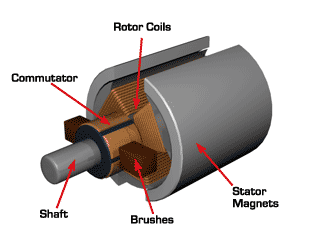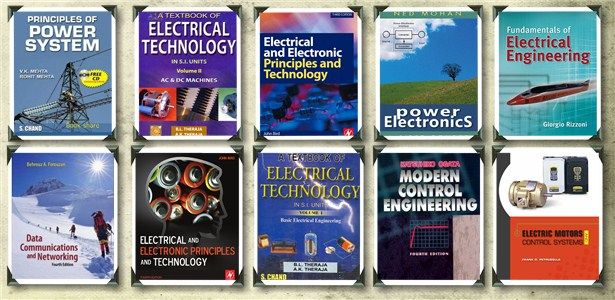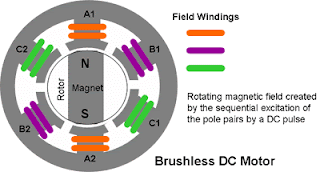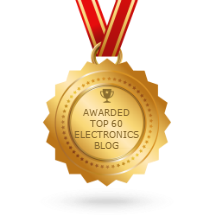Electric Motor
An Electric motor is a machine, which converts electric
energy into mechanical energy. The reverse of this is the conversion of
mechanical energy into electrical energy and is done by an electric generator.
Its action is based on
the principle that when a current-carrying conductor is placed in a magnetic
field, it experiences a mechanical force whose direction is given by Fleming’s
Left-hand Rule and whose magnitude is given by F = BIL Newton.
Electric motors are used
to produce linear or rotary force (torque), and should be distinguished from
devices such as magnetic solenoids and loudspeakers that convert electricity
into motion but do not generate usable mechanical powers, which are
respectively referred to as actuators and transducers.
 |
| Squirrel Cage Motor |
Types of Motors
Classification Based On Power Supply:
1. Alternating Current (AC) Motors.
2. Direct Current (DC) Motor.
Types of AC Motors
Classification Based on Principle of Operation:
1. Synchronous Motors.
Depending on how the rotor is magnetized:
(a) Non-excited
i. Reluctance motors
ii. Hysteresis motors
iii. Permanent magnet motors
(b) Direct-current excited.
2. Asynchronous Motors.
(a) Induction Motors:
i. Squirrel Cage (Single & Double)
ii. Slip-Ring (external resistance).
(b) Commutator Motors:
i. Series
ii. Compensated
iii. Shunt
iv. Repulsion
v. Repulsion-start induction
vi. Repulsion induction
Classification Based On Type of Current:
1. Single Phase
2. Three Phase
Classification Based On Speed of Operation:
1. Constant Speed.
2. Variable Speed.
3. Adjustable Speed.
Classification Based On Structural Features:
1. Open
2. Enclosed
3. Semi-enclosed
4. Ventilated
5. Pipe-ventilated
6. Riveted frame-eye etc.
Types of DC Motor
Most common DC motor types are-
1. Permanent-magnet DC motor
2. Electrically excited DC motor
(a)
Separately excited
(b) Self Excited
i. DC shunt-wound motor
ii. DC series-wound motor
iii. DC compound motor
- Cumulative compound
- Differential compound
3. Brushless DC Motor
4.
Coreless or ironless DC motors
5. Printed armature or pancake DC motors
6. Universal motors (AC or DC)
(a) Concentrated pole, non compensated type (low power rating)
(b) Distributed field compensated type (high power rating)
Overview of AC Motors
1. Synchronous Motors:
A synchronous electric motor is an AC motor in which, at steady state, the rotation of the shaft is synchronized with the frequency of the supply current; the rotation period is exactly equal to an integral number of AC cycles.
Because its speed remains constant under varying loads, it is used for driving continuously-operating equipment at constant speed. These motors have the rotor (which is connected to the load) rotating at the same speed as the speed of rotation of the stator current. In other words, we can say these motors don't have slip with respect to the stator current. They are sometimes used
no to drive the
load but instead act as "synchronous condenser", to improve the power factor of the local grid to which it is connected to. They can also act as stepper motors.
 |
| A synchronous motor-generator set for AC to DC conversion. |
Uses:
- Synchronous motors find applications in all industrial applications where constant speed is necessary.
- Improving the power factor as Synchronous condensers.
- These kind of motors are used even in high precision positioning devices like modern robots, ammonia and air compressors, motor-generator sets, continuous rolling mills, paper and cement industries.
2. Reluctance motors:
These have a rotor consisting of a solid steel casting with projecting (salient) toothed poles. Typically, there are fewer rotor than stator poles to minimize torque ripple and to prevent the poles from all aligning simultaneously—a position which cannot generate torque.
Uses:
Reluctance motor designs have ratings that range from fractional horsepower (a few watts) to about 22 kW. Very small reluctance motors have low torque, and are generally used for instrumentation applications.
3. Hysteresis motors:
These have a solid smooth cylindrical rotor, cast of a high coactivity magnetically "hard" cobalt steel. This material has a wide hysteresis loop (high coactivity), meaning once it is magnetized in a given direction, it requires a large reverse magnetic field to reverse the magnetization.
Uses:
Hysteresis motors are manufactured in sub-fractional horsepower ratings, primarily as servomotors and timing motors. More expensive than the reluctance type, hysteresis motors are used where precise constant speed is required.
4. Permanent magnet motors:
A permanent magnet synchronous motor (PMSM) uses permanent magnets embedded in the steel rotor to create a constant magnetic field. The stator carries windings connected to an AC supply to produce a rotating magnetic field. At synchronous speed the rotor poles lock to the rotating magnetic field. Permanent magnet synchronous motors are similar to brushless DC motors.
Uses:
Permanent magnet motors have been used as gearless elevator motors since 2000.
5. Asynchronous Motors:
An induction or asynchronous motor is an AC electric motor in which the electric current in the rotor needed to produce torque is obtained by electromagnetic induction from the magnetic field of the stator winding. The most common form of motor which is used in everyday life
from pumping water up the overhead tank to power plant boiler feed pumps, these kind of motors rule. These motors are very flexible to use and matches the load demand almost for everything. The most widely used Induction Motors are very important for many industries due to their load bearing capacity and flexibility. These motors, unlike synchronous motors, slip when compared to the stator current field.
 |
| Cutaway view through stator of TEFC induction motor. |
Uses:
They are generally used for various types of pumps, compressors and acts as prime movers for many types of machinery.
6. Squirrel Cage Induction Motors:
This motor is quite simple but rugged and possesses high overload capacity. It has a nearly constant speed and poor starting torque.
Uses:
Squirrel cage induction motor is used for low and medium power drives where speed control is not required as for water pumps, tube wells, lathes, drills, grinders, polishers, wood planers, fans, blowers, laundry washing machines and compressors etc.
7. Double Squirrel Cage Motor.
It has high starting torque, large overload capacity and a nearly constant speed.
Uses:
It is used for driving loads which require high starting torque such as compressor pumps, reciprocating pumps, large refrigerators, crushers, boring mills, textile machinery, cranes, punches and lathes etc.
8. Slip Ring Induction Motors:
It has high starting torque and large overload capacity. The speed of slip ring induction motor can be changed up to 50% of its normal speed.
 |
| 6,000 kW slip ring induction motor for compressor test bench (photo credit: emz.de) |
Uses:
The Slip ring induction motor is used for those industrial drives which require high starting torque and speed control such as lifts, pumps,
winding machines, printing presses, line shafts, elevators and compressors etc.
9. Single-phase Series Motor:
It possesses high starting torque and its speed can be controlled over a wide range.
Uses:
It is used for driving small domestic appliances like refrigerators and vacuum cleaners etc.
10. Repulsion Induction Motors:
It has high starting torque and is capable of wide speed control. Moreover, it has high speed at high loads.
Uses:
Repulsion motor is commonly used for drives which require large starting torque and adjustable, but constant speed as in coil winding machines.
11. Single & Three Phase Motors:
The A.C. Motors can find their usage in 2 forms based on their power supply. The single phase motors are generally found their use in low power requirements/domestic appliances like ceiling fans, mixer grinders, portable power tools etc.
 |
| Single & Three Phase Motors |
Uses:
The three phase motors are generally found for high power requirements like power drives for compressors, hydraulic pumps, air conditioning compressors, irrigation pumps and many more.
12. Constant, Variable & Adjustable Speed Motors:
As already said, A.C. Motors are highly flexible in many ways including their speed control. There are motors which should be run at a constant speed for air compressors. Certain cooling water pumps driven by a.c. motors can be run at two or three speeds by just switching the number of poles used. If the number of poles is changed then the speed also changes.
Uses:
These serve best for sea water cooling pumps in marine engine room applications & many power plants. The speed of the motors can also be varied continuously by some electronic arrangements thus this can be suited for certain applications like a ship's cargo pump, whose discharge rate has to lowered as per the terminals requirement.
13. Varied Structure Motors:
These types of motors have different outer cage arrangements, depending upon the usage or any special industrial requirement. For motors used in gas and oil terminals, the casing must be of intrinsically safe, thus it may either have a enclosed casing or a pipe ventilated arrangement such that the sparks produced inside the motor does not cause a fire outside it.
Uses:
Also many motors are totally enclosed as it may be open to weather like those used in hydro-electric power plants.
Overview of DC Motors
1. Permanent-magnet DC (PMDC) motors:
A permanent-magnet motor does not have a field winding on the stator frame, instead relying on permanent magnets to provide the magnetic field against which the rotor field interacts to produce torque. Compensating windings in series with the armature may be used on large motors to improve commutation under load. Because this field is fixed, it cannot be adjusted for speed control. Permanent-magnet fields (stators) are convenient in miniature motors to eliminate the power consumption of the field winding. Larger DC motors are of the "dynamo" type, which have stator windings. Historically, permanent magnets could not be made to retain high flux if they were disassembled; field windings were more practical to obtain the needed amount of flux. However, large permanent magnets are costly, as well as dangerous and difficult to assemble; this favors wound fields for large machines.
 |
| Permanent-magnet DC motor |
Uses:
To minimize overall weight and size, miniature permanent-magnet motors may use high energy magnets made with neodymium or other strategic elements; most such are neodymium-iron-boron alloy. With their higher flux density, electric machines with high energy permanent magnets are at least competitive with all optimally designed singly-fed synchronous and induction electric machines. Miniature motors resemble the structure in the illustration, except that they have at least three rotor poles (to ensure starting, regardless of rotor position) and their outer housing is a steel tube that magnetically links the exteriors of the curved field magnets.
2. D.C. Series Motor:
Since it has high starting torque and variable speed, it is used for heavy duty applications such as electric locomotives, steel rolling mills, hoists, lifts and cranes.
3. D.C. Shunt Motor:
It has medium starting torque and a nearly constant speed. Hence, it is used for driving constant-speed line shafts, lathes, vacuum cleaners, wood-working machines, laundry washing machines, elevators, conveyors, grinders and small printing presses etc.
4. Cumulative Compound Motor:
It is a varying-speed motor with high starting torque and is used for driving compressors, variable-head centrifugal pumps, rotary presses, circular saws, shearing machines, elevators and continuous conveyors etc.
5. Brushless DC motors:
Some of the problems of the brushed DC motor are eliminated in the brushless design. In this motor, the mechanical "rotating switch" or commutator/ brushgear assembly is replaced by an external electronic switch synchronized to the rotor's position. Brushless motors are typically 85–90% efficient or more (higher efficiencies for a brushless electric motor, of up to 96.5%, were reported by researchers at the Tokai University in Japan in 2009), whereas DC motors with brushgear are typically 75–80% efficient. Modern DC brushless motors range in power from a fraction of a watt to many kilowatts.
Uses:
Larger brushless motors up to about 100 kW rating are used in electric vehicles. They also find significant use in high-performance electric model aircraft.
Brushless DC motors are commonly used where precise speed control is necessary, as in computer disk drives or in video cassette recorders, the spindles within CD, CD-ROM (etc.) drives, and mechanisms within office products such as fans, laser printers and photocopiers.
6. Coreless or ironless DC motors:
Nothing in the design of any of the
motors described above requires that the iron (steel) portions of the rotor actually rotate; torque is exerted only on the windings of the electromagnets. Taking advantage of this fact is the
coreless or ironless DC motor, a specialized form of a brush or brushless DC motor. Optimized for rapid acceleration, these motors have a rotor that is constructed without any iron core. The rotor can take the form of a winding-filled cylinder, or a self-supporting structure comprising only the magnet wire and the bonding material. The rotor can fit inside the stator magnets; a magnetically
soft stationary cylinder inside the rotor provides a return path for the stator magnetic flux. A second arrangement has the rotor winding basket surrounding the stator magnets. In that design, the rotor fits inside a
magnetically soft cylinder that can serve as the housing for the motor, and likewise provides a return path for the flux.
 |
| Figure: Coreless DC motors |
Because the rotor is much lighter in weight (mass) than a conventional rotor formed from copper windings on steel laminations, the rotor can accelerate much more rapidly, often achieving a mechanical time constant under 1 ms. This is especially true if the windings use aluminum rather than the heavier copper. But because there is no metal mass in the rotor to act as a heat sink, even small coreless motors must often be cooled by forced air.
Uses:
Related limited-travel actuators have no
core and a bonded coil placed between the poles of high-flux thin permanent magnets. These are the fast head positioners for rigid-disk ("hard disk") drives.
7. Printed Armature or Pancake DC Motors:
A rather unique motor design the pancake/printed armature motor has the windings shaped as a disc running between arrays of high-flux magnets, arranged in a circle, facing the rotor and forming an axial air gap. This design is commonly known the pancake motor because of its extremely flat profile, although the technology has had many brand names since its inception, such as ServoDisc.
The printed armature (originally formed on a printed circuit board) in a printed armature motor is made from punched copper sheets that are laminated together using advanced composites to form a thin rigid disc. The printed armature has a unique construction, in the brushed motor world, in that is does not have a separate ring commutator. The brushes run directly on the armature
surface making the whole design very compact.
Uses:
These motors were originally invented to drive the capstan(s) of magnetic tape drives, in the burgeoning computer industry. Pancake motors are still widely used in high-performance servo-controlled systems, humanoid robotic systems, industrial automation and medical devices. Due to the variety of constructions now available the technology is used in applications from high temperature military to low cost pump and basic servo applications.
8. Universal Motors:
A universal motor is defined as a motor which may be operated either on direct or single phase AC supply at approximately the same speed and output. It is a
commutated series-wound motor where the
stator's field coils are connected in series with the rotor windings through a commutator. It is often referred to as an AC series motor. The universal motor is very similar to a DC series motor in construction, but is modified slightly to allow the motor to operate properly on AC power. This type of electric motor can operate well on AC because the current in both the field coils and the armature (and the resultant magnetic fields) will alternate (reverse polarity)
synchronously with the supply. Hence the resulting mechanical force will occur in a consistent direction of rotation, independent of the direction of applied voltage, but determined by the commutator and
polarity of the field coils. Universal motors have high starting torque, can run at high speed, and are lightweight and compact.
 |
| Universal Motor |
Uses:
The Universal motor is used for the purposes where speed control and high values of the speed are necessary. The various applications of the Universal Motor are Portable drill machine, Used in hair dryers, grinders and table fans. A universal motor is also used in Handheld power tools, blowers, blenders, vacuum cleaners, polishers and kitchen appliances.
Download this Article as PDF:





























